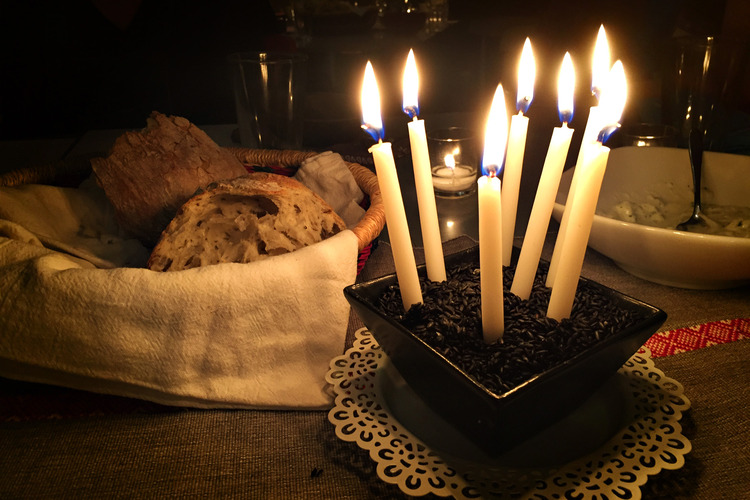Johann Tetzel had a chest
Photo of the Day from Tuesday Jan 3 from the Luther exhibit at the Morgan Library.
Photo of the Day from Tuesday Jan 3 from the Luther exhibit at the Morgan Library.
Hidden Figures. Great movie
Our sabbatical continues, and today you get more than one photo. Wohoo! Lisa and I worshipped at St. Lydia's in Brooklyn, NY this evening. If not the originators of the dinner church concept, then pretty close. The concept is simple. Host a simple meal, merge it with some elements of liturgy and a casual atmosphere of people talking to one another.

As someone that usually enter's new situations with a tad bit of reluctance, it was nice to be put to work right away. I washed dishes. THe pre-wash, aka, washing the pots and pans that were used by Andie, this evenings cook.

It was the music that stole my soul. Simple accapella singing and chant. My mystical preferences were in delight.

Then there was the atmosphere and the bread, and of course The Bread.

Well, at least that is the plan. The goal is simple, post one photo per day for the next three months during my 2017 sabbatical. If I have words to add, I will, if not - well, be thankful you got the photo. We start today, Dec 31, 2016.
I was in a store today, picking up a few non-essential items for our trip, and as I exited, I noticed this sign. What a great idea! What if our churches had something similar? Forget the card in the bulletin, that no one uses. Instead, have them text you. My guess is that if you get 50 texts over the course of a few months, 49 will be trivial and unhelpful. Especially, the ones that you know are coming from Hank, who always complains. But, you'll get one that just might be worth it. In addition, visitors might be more willing to text than sign a guest book or fill out a card. Just a thought.
Day 1, the project begins.

As I depart for my Winter Sabbatical, I'll be posting photos from travels along with whits and wisdom, or drivel, however you choose to read it.
In the meantime, here is a video of my Summer 2016 bishop on a bike ride to Ohio along the Erie Canal, complete with over-the-top Epic soundtrack.
I've been watching short films on Vimeo lately, as a way to get inspired for some creative projects. I found this 4 minute film intriguing.
NOW from Dani Fortuny on Vimeo.
Click the above link, you'll be happy you did.
The grief is both real and anticipatory.
The church member knows his or her church is in decline.
That member knows some things must change or the church is headed for more rapid decline or even death.
But change is difficult. These members want their old church back. They want to do things the way they’ve always done them.
That church of the past, however, will not return. The pace of change is faster than ever, and it will only increase.
How do we respond to these hurting, and sometimes, angry people? Here are five responses.
These days are days of rapid change. Congregations have not been immune from the impact of the change. We must always love people. But we cannot let one or a few hinder us from the work to which God has called us. via Thom Rainer
Yesterday, we all awoke to a new reality in our country – indeed in our world. The election that has consumed so much energy and time, and in a manner that was not at all reflective of our better selves, came to a conclusion. I know from many conversations that we have people in our synod, in our congregations and communities who are dismayed and afraid, we also have others who view the results positively.
In the words of my colleague, Bishop Alan Gates: “Our national election is behind us, leaving in its wake a legacy of bitterness and hostility. For some, alienation is the apparent reason for the election’s outcome; for others alienation is its result. In either case, we face grievous division and manifest anxiety.”
In light of these election results, I believe it is incumbent upon us all to view ourselves as agents of healing. We have wounds all across the spectrum, and I believe we need to address those wounds. I will be candid and say that I have more questions than answers.
How do we move forward? What do we do with all the language of vitriol, hatred, threats, lies, accusations, racial & sexual discrimination that have been hurled around? How do we address the economic anxiety that is very much a part of our country? What is the role of the church in these times? What is an appropriate prophetic voice for today? Where is God in our emotional and intellectual response? And others…
I offer some wisdom from a family member who works in the field of election campaigns going back to 1980. He writes: “Victory is never as revolutionary as one imagines. Defeat is never the Armageddon we fear. I’ve been there [on both sides over the years.] We have a constitutional system that will continue. … Yes there is a world of unknowns come January. But the policies that effect our lives will evolve with the traditional frustrating slowness of the legislative process.”
Finally, I offer this prayer as a tool for each of us to take an inventory of our own place in this time of evaluation and healing.
“God, our refuge and strength, you have bound us together in a common life. In all our conflict, help us to confront one another without hatred or bitterness, to listen for your voice amid competing claims, and to work together with mutual forbearance and respect; through Jesus Christ our Lord.” -Evangelical Lutheran Worship, Pastoral Care book, p. 386
Sincerely in Christ
Bishop James Hazelwood
Some recent quotes I've heard or read:
- Donald Trump has let pain in the room of US American politics.
- Martin Luther probably wouldn't have distributed the 95 theses, if he had to do it over again.
- I used to believe in programs, now I only believe in people.
- Why can't we believe in both individual responsibility & collective responsibility.
- I don't know what God is anymore, but I do know when I see Life.
- Politics is dead, we now need some new way of talking across our differences.
These are a variety of statements that have stood out to me in my reading and conversations over this election year. They come from people who are well known to the world as well as people who don't even have an online profile. They have stuck with me. I really don't know what they have to do with one another, but that's something I want to think about - out loud, here.
So I am hoping over the next few months to use this space as a place for conversation on the subject of recovering the art of dialogue. Mynapproach will be to look at seemingly complex issues in our world today, and engage a both/and conversation, as opposed to an either/or debate. This doesn't mean I plan to be neutral, but I do want to engage a broader view.
Why do this? Mostly, it's selfish. I've found myself locked into the same polarity that has gripped our country. Of late, I'm realizing that this systemic shift in our national dialogue is actually leaving out space for solutions. In short, we'd rather be justified in our positions, than find a solution.
So this little experiment is really an opportunity to engage in topics no one wants to tyalk about, because they are so volatile. I want to dive into those topics. We will see where it goes, and if it goes.
This week I am in California giving the presentation I've become known for "Where in God's Name are We?" I'm talking about Nones and Dones. Here is a link to the Powerpoint presentation. You can download it here. You can also download a print version in a PDF Click here
Vote. Enourage others to Vote.
I had in mind a long reflective article on this subject. Basically, my bottom line came down to the above, so I'll save your eyeball time. November 8 is election day. Not only for President, but other elected positions. Those local ballot initiatives are important as well. I'm not gonna tell you how to vote, you go figure that out for yourself. All I'm doing here is telling you that you gotta vote, it's just part of the deal of being a citizen.
Thom Rainer assembles some great resources for churches. You should follow him. yes, I know he is Southern Baptist, but the guy knows congregational life
Here are his thoughts on what's dying, at the Bottom, I talk about what's Living
Technological advancements and cultural changes have ushered in new practices in church communications. As a result, these seven practices are not only being replaced, they are dying.
The above are from Thom's blog, below are my thoughts on what we can do about it.
OK So, these worked in the past, and some are still working, I think # 6 still has value for internal communication.
So what's working now.
First, let's acknowledge that churches are competing with a multi-billion dollar marketing monster. We are not going to win that game.
Second, people are busy. So it's really, really, tough to get your messsage out. You need multiple ways of doing it. People need to hear it 7 times in many different ways before they absorb it.
Third, Video is the new king. Spend the money and get trained at www.thevj.com Worth every penny. Start using video. We live in a screen world. You don't need a $20,000 camera, your iPhone is all you need. Most people are watching video on their phones, so who cares if it's in HD.
Fourth, still, the absolute BEST way to communicate is via personal invitation. This has the highest success rate of any tool out there.
Fifth. Go old school. Little cards, and hand written notes, yup, they work too. Why cause in an impersonal world, a personal note sends a message. You matter.
James Carvelle made famous the statement, "It's the economy, stupid." in 1992 during the presidential election. It was made to his campaign staff as a way to focus their attention on the central issue that he believed defined that election year. This post is not about the election, it's about what is central to the life of people who follow in the walk of Jesus.
It's the Spiritual.
Now before I describe some new/old ways I'm attempting to recover a more focused life in the spirit, let me begin by acknowledging that Lutheran theologians have often guarded against dividing the spiritual and the material. We tend to see God in the everyday. We don't divide out the spiritual life from the meal at lunch, the crucial conversation with your boss or the work you are doing for affordable housing in your community. It's all integrated. That's true for me as well.
Lately, I'm finding a need to find a center that will help me live into those everyday experiences. The shape they are taking is found in three resources.
First is exercise and diet. I've written about this elsewhere, so I won't go in to detail here. But I'm amazed how eating well and exercising, even if it's just a walk in the neighborhood, has helped me connect with my body. There is a spirituality to that.

Second, is this little book of Psalms in the translation by Eugene Peterson. I love reading a Psalm either outloud or quietly to myself. Check it out. The Psalms will come to life for you in ways they haven't for a long time. Traditionalists tend to not like the Message versions of some of their favorite passages, and I get that. So don't use it for Psalm 23, but read Psalm 58 for a new twist on the political reality of life in the 5th century BCE, and see if it doesn't apply to today. Or lift your spirits with Psalm 103. Such life. Peterson is a poet with language.
 Third is a app on my phone called HeadSpace. It's a program of guided meditation for 10 minutes. I start out everyday with this meditation. It helps me center and focus. One ways I adjust the meditation is instead of counting my breaths, 1,2,3,4.. as instructed, I use the Hebrew word for God Yahweh. Breathe in Yah, breathe out Weh. My wife introduced this idea to me based on a reading of Richard Rohr.
Third is a app on my phone called HeadSpace. It's a program of guided meditation for 10 minutes. I start out everyday with this meditation. It helps me center and focus. One ways I adjust the meditation is instead of counting my breaths, 1,2,3,4.. as instructed, I use the Hebrew word for God Yahweh. Breathe in Yah, breathe out Weh. My wife introduced this idea to me based on a reading of Richard Rohr.
My morning is now ten minutes of HeadSpace, followed by a reading of a Psalm. It's my place of Peace with God before tackling the daily ups and downs of this spiritual/material mixed up life. So, far it seems the Peace of God is working her way into the everyday.
That would be House for All Saintys and Sinners, and ELCA Lutheran COngregation in Denver, CO
Thom Rainer posted this today.
“In the past, I’ve been able to lead churches to growth. I can’t do it anymore. I don’t know what’s wrong with me.”
A pastor shared those sentences with me just three days ago.
He was frustrated. He was confused. He was exhausted.
And he is not alone.
With some exceptions, it is indeed more difficult to lead churches to growth. Such is a reality that is about 15 years in the making. The obvious question is “Why?” Allow me to articulate five of those reasons.
If you think it is more difficult to lead a church to growth, you are right. If you have noticed the decline in your church is greater, you are probably right as well. And if you are to the point of realization that your church may die in the next few years, it may come sooner than that.
Thank you to Mark and Sarah Huber of Sanctuary for this great song.
Last weekend I was in Honduras for the dedication of a new church building that began in 2005, when I was Pastor at St. Andrew. So nicve to be a part of the completion of this project.